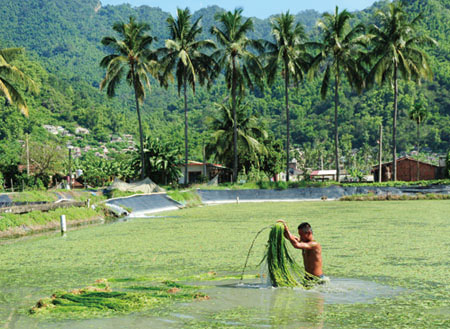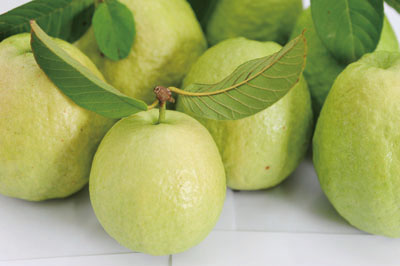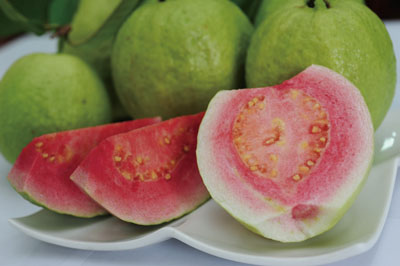Wild Lotus Farming in Meinong / 美濃 野蓮
Wild Lotus Farming in Meinong
◎English translation: Peng Hsin-yi
◎Photos by Pao Chung-hui

In Meinong, wild lotus farmers are hard at work harvesting their crops. Wild Lotus (Latin: Nymphoides cristata) is an aquatic plant with an edible stem. The harvest requires farmers to submerge their bodies, leaving only their heads above water. They can't see the crop through the water, so they rely solely on their sense of touch. After obtaining a handful, they carefully tie them into neat bunches and place them under damp cloths to prevent dehydration. They then return to the ponds to get another bunch.
Lotus farmer Mr. Li Dong-jhen has three fields, totaling three kaes (about 7.2 acres) and enjoys a daily output of 555 Taiwanese Catties (about 330 kilos, or 727 lbs). Mr. Li points out the lotus can only grow in natural spring water. In the summer, they can be harvested in 70 to 80 days, whereas it is about 100 days in winter. When he began there was no existing documentation on how to grow wild lotus, so Mr. Li had to learn by trial and error. He uses an organic fertilizer and absolutely no chemical treatments. However, occasionally the plants get sick and the whole crop must be destroyed. The pond must be sterilized and the whole process must begin again.
Mr. Li feels the most challenging aspects of wild lotus farming is harvesting. This is especially true during winter when the weather is cold and farmers must stay in the bone-chilling water for many hours. However, the crop is delicious and crunchy, with a crisp texture. It is usually served as a mildly seasoned stir-fry. The flavor is refreshing and can be found in many local restaurants. However, due to the fact it is grown with organic fertilizers and pure water, it tastes great in salads.
美濃 野蓮
◎文/侯雅婷 ◎攝影/鮑忠暉

頂著豔陽,野蓮養殖戶已在水池工作多時,由於野蓮的根部生長於池底,只見他們稍稍蹲低身體,僅剩頭露出水面,憑著手感在水面下採集瘦瘦細長的野蓮,採集到一整束的野蓮,稍做整理後,綑成一束,再繼續採集的工作,採集好的野蓮,隨即用濕布包覆住防止水份的流失。
美濃獨有的野蓮料理方式多以大火快炒,野蓮因為空心的構造,吃起來清爽帶點脆脆的獨特口感,是必點的佳餚。
農戶李東振養殖野蓮面積達3甲,每天出貨量約550台斤。李東振表示養殖野蓮使用地下水,夏天生長期為70~80 天,冬天約須100天。李振東說養殖野蓮沒有老師,要種出好吃的野蓮需使用有機肥料施肥,此外,一旦發現野蓮生病,就只有忍痛將整池的野蓮全數銷毀再重新來過。當被問起這一行的甘苦談 ,李振東表示,拔野蓮最是辛苦,特別是在冬天時,凍得直打哆嗦卻仍得下池工作。李振東養殖的野蓮多以大批發的方式銷往全台果菜市場。另一位野蓮農戶古鎮賢強調,野蓮是非常好的蔬菜,因為水質乾淨且施用有機肥料,生吃都沒問題。
Yenchao's Red Guavas
◎English Translation: Peng Hsin-yi
◎Photos by Pao Chung-hui
Guavas are Yenchao's most famous fruit and more popular than Taiwan's regular guavas. Due to a nearby, dormant mud volcano, Yenchao's soil is high in nutrients and clay. Yenchao's red guavas are slightly tart, but delightfully sweet. They have a soft, buttery texture and are cruncher than other varieties.

Mr. Huang Lian-cheng, has been farming guavas in Yenchao for over twenty years. Three years ago, Mr. Huang grew a new and improved guava which has an aroma that slightly resembles passion fruit, similar to Taiwan's original guava. In order to illustrate his description, he slices the guava in half to reveal the vitamin C rich, pink fleshy interior. Red guavas(The pink interior) are also high in lycopene and on hotter days they have a milder fragrance and are lighter in color. When they ripen, they develop a deep shade of pink and are much more fragrant.
The key to picking good red guavas is to select fruits that are perfectly rounded and green in appearance. Red guavas are also particularly vulnerable to soft rot disease, which begins as blemishes and develops into sores that appear on the fruits' exterior. This disease will eventually rot the whole fruit and is a great challenge for guava farmers to combat.
Currently there are only 20 hectares of red guava orchards in Yenchao, small in comparison with the other guava orchards in the area. Therefore, red guavas cost at least two or three times more than its counterpart. The majority of red guava is absorbed by the domestic market, with a small percent being exported to Hong Kong at 100NT per kilogram. Consumers in Hong Kong love its taste and fragrance. Mr. Huang believes his red guavas are of high economic value and his investment worthwhile. He is always working to improve his farming technique, as well as finding ways to prevent soft rot disease.
燕巢 紅心芭樂
◎文/張嘉玲 ◎攝影/鮑忠暉

燕巢芭樂遠近馳名,得天獨厚的黏土土質,還有泥火山特殊地質造就燕巢芭樂果肉酸、甜、甘的獨特風味 。三年前,栽種芭樂超過二十年的黃連成開始栽種經改良過的紅心芭樂,該品種果肉質地較一般紅心芭樂硬脆。他表示,紅心芭樂果肉呈現討喜的鮮紅或淡粉色澤,散發濃郁的百香果香氣,與台灣土芭樂味道類似。
剖開紅心芭樂,帶著鮮紅色澤的心形果肉是紅心芭樂的註冊商標,黃連成表示,芭樂的維生素C豐富,紅色果肉部份更富含茄紅素。天氣越炎熱,果肉顏色、香氣都較淡,嘗起來清脆爽口。存放時間越久,果肉顏色則會加深,香氣轉濃。黃連成說,挑選紅心芭樂時,外觀渾圓、顏色翠綠的芭樂為首選,果實的首、尾端甜度分佈平均。
紅心芭樂最怕得到軟腐病,果皮表面會形成斑點,日漸腐爛,不易種植。黃連成表示,現在還沒有辦法完全克服軟腐病的問題。目前燕巢區的紅心芭樂總栽種面積約20公頃,總產量少,銷售價格為一般芭樂的兩三倍以上,大部分內銷居多,因口感、香氣深受港人喜愛,故以香港為主要外銷市場,外銷價格每公斤直逼百元,經濟價值頗高。黃連成說,未來必須要透過提昇種植技術,研究抗軟腐病的防治辦法,紅心芭樂的總產量才能提昇。